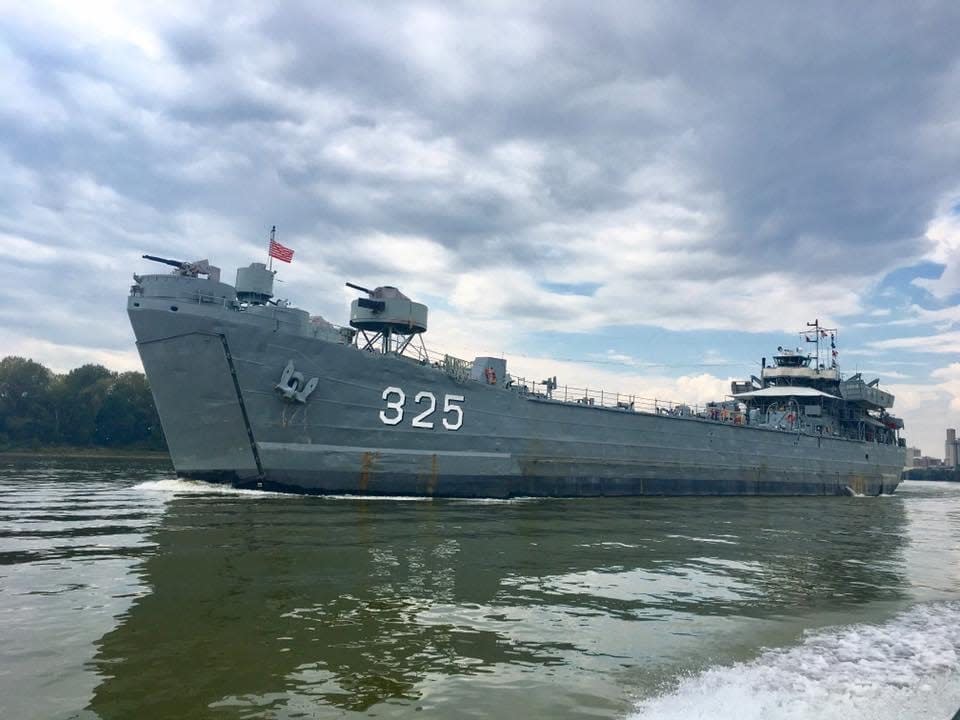A World War II warship will dock in three US cities and you can explore it. Here's how and where
A one-of-a-kind World War II-era ship that helped turn the tide for the Allies will be moored and open for tours in three U.S. cities starting at the end of August.
The chance to board the USS LST 325, the last fully functional Landing Ship Tank remaining in the country, will appeal to history junkies and maritime buffs everywhere.
The ship is docked and open for tours in Evansville, Indiana eleven months out of the year, but will take its annual voyage to three port cities.
This year, the USS LST 325 will visit La Crosse, Wisconsin; Dubuque, Iowa; and Hannibal, Missouri over the course of a month.
The ship has sailed on the Ohio and Mississippi rivers and has docked in places such as Nashville, Tennessee; Vicksburg, Mississippi; and Pittsburgh, Pennsylvania.
Here's everything you need to know if you plan on visiting the LST 325 in a couple of weeks.
Here’s when the LST 325 will be moored in your city
August 31 to September 4: La Crosse, Wisconsin.
September 7-12: Dubuque, Iowa.
September 15-18: Hannibal, Missouri.
Visitors will be able to tour the ship between 9 a.m. and 5 p.m. The cost is $15 for adults, $7 for child ages 6 to 17 and free for children 5 and younger.
Your admission includes a self-guided walking tour of the vessel, but guided tours are also available upon request.
Skywatchers rejoice: This August, you'll see a rare blue moon − plus another supermoon
What will the tours entail?
The LST's mission was once to deliver tanks, vehicles, supplies, cargo and troops directly onto enemy beaches. Now it is used to teach people about the roles of LSTs in World War II and in the Korean and Vietnam wars, highlighting the sailors who manned it in those conflicts.
The annual cruises aim to introduce LST 325 to a larger geographic area to raise awareness and donations needed to preserve and maintain the ship.
The self-guided tours, which take visitors along a designated route including six flights of stairs and last about 45 minutes, give people an opportunity to explore a vessel that participated in the D-Day invasion. The ship is outfitted to match what it looked like during its World War II service. Visitors will be able to explore areas such as the main deck, troop berthing area, the tank deck, the mess, galley, wheelhouse, the officers' areas and the captain's cabin.

What makes the LST so special?
LSTs were built during World War II to help Allied forces invade areas held by the enemy. LSTs had specially designed hulls and flat bottoms that allowed them to run their bow directly onto beaches and unload their cargo, according to the United States LST Association. They could land on just about any type of shore that had a gradually sloped beach.
At the time, the ship was the largest of the vessels used by by the newly created Amphibious Forces.
Was it dangerous to serve on an LST?
Yes. Several crew members of LST 325 were wounded by air attacks during World War II, according to the LST Ship Memorial website.
LST's were lightly armed, typically with seven 40 mm and 12 20 mm antiaircraft guns. The LST 325 has guns as it did in World War II; 40 mm rounds were fired when the ship was moved in 2020 from a marina to its current, more-visible downtown location, according to the Evansville Courier & Press.
The ships were powered by two diesel engines and plowed through the water with a maximum speed of 11.5 knots, or just over 13 mph. Sailors nicknamed the ships "Large Slow Target," according to the LST Association.
What did LST 325 and its crew do during World War II?
After its February 1943 shakedown cruise around Norfolk, Virginia, the ship and her crew sailed to New York City and then left for Oran, Algeria, according to the LST Ship Memorial website.
Among some of its duties throughout the war, the ship supported Allied military forces in Tunisia in North Africa and Sicily and Salerno in Italy. It was involved in training exercises in preparation for D-Day, and unloaded men and vehicles onto smaller craft while anchored off Omaha Beach during the Allied invasion of France.
After that, it supplied Allied forces battling the German Army in France, and on Dec. 28, 1944, helped rescue about 700 men from a troop transport that was torpedoed off the coast of France.
A look back at D-Day: Why the World War II invasion remains important on its 79th anniversary
Why is LST 325 permanently moored in Evansville, Indiana?
LST 325 served the Greek Navy from 1964 until December of 1999, when it was decommissioned. It then was purchased by the LST Ship Memorial, a nonprofit group that aims to preserve the ship and use it for educational purposes. The ship ended up in its home port of Evansville because the city has a historic link to LSTs, said Cory Burdette, museum operations coordinator, in an email interview.
He said shipbuilders across the United States made 1,051 LSTs during World War II, but the Evansville builder, Missouri Valley Bridge and Iron Co., made the most, 167.
"We're kind of like the 'LST capital,' so to speak," Burdette said.
Also, he added, being on the Ohio River allows the ship to cruise within days to major cities in the middle of the U.S., including Chicago, Indianapolis and St. Louis.
Keith Uhlig is a regional features reporter for USA TODAY NETWORK-Wisconsin based in Wausau. Contact him at kuhlig@gannett.com and follow him at @UhligK on Twitter and Instagram or on Facebook.
This article originally appeared on Green Bay Press-Gazette: How to see this World War II warship coming to three US cities

